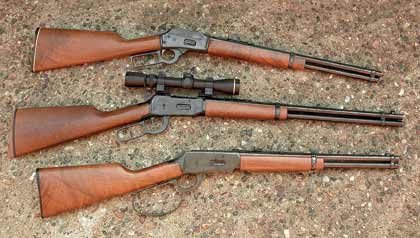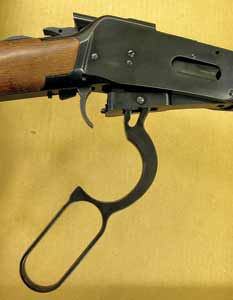September 23, 2010
By G&A Staff
Our technical editor says Mossberg's brand-new Model 464 lever-action is both traditional and modern.
By Dick Metcalf, R.L. Window
Other than apple pie, I know of nothing more quintessentially American than the .30-30 lever-action deer rifle--as exemplified in myriad western movies and television shows and on the gun racks of millions of hunters by the classic Winchester Model 94.
Of course, the Model 94 is no more; in 2006, Winchester closed the New Haven, Connecticut, factory where it had been manufactured for more than 100 years. But fear not. Now comes the new Model 464 .30-30 lever-action rifle from O.F. Mossberg & Sons--a gun that faithfully evokes the traditional look, feel, and appeal of the traditional Winchester while also incorporating several unobtrusive refinements and design improvements that make it worthy of any 21st-century shooter and hunter.
Advertisement
Mossberg, which is located in North Haven, Connecticut, (just a scant 5 miles up the pike from the old Winchester facility) was fully aware of the enduring popularity of the great American lever-action and of the manufacturing and quality problems plaguing Winchester's Model 94 production. Mossberg had already decided to build its own traditional-format M94-type rifle well before the shocking announcement that Winchester was shutting down, leaving Marlin as the only remaining significant competitor in this portion of the lever-action market.
It was also merely coincidence that at almost the same time, Hornady introduced its new LEVERevolution ammunition line featuring FlexTip spitzer bullets, providing significantly enhanced ballistic performance for all traditional lever-action cartridges.
Advertisement
All in all, it was nice timing.
Traditional And Modern
Put a new Mossberg Model 464 side by side with a Winchester 94 (or a Marlin Model 1894) and the resonance is obvious. The Mossberg 464 has the familiar slim, flat-sided receiver; two-piece, straight-grip stock; receiver-side loading port; tubular magazine with barrel band; and exposed hammer. Like both the Winchester and Marlin designs, the Model 464 action is operated by a forward stroke of the straight-looped lever, which directly engages the bolt. There is neither cam nor link-arm nor the "geared" rack-and-pinion design used by the modern (1971) Browning BLR to shorten its lever travel. The Mossberg 464 feels and operates like John Wayne's favorite rifle.
In function, the Model 464 is similar to the Winchester Model 94 Angle Eject design. The receiver is open-topped with the right side slightly lowered to allow sideways ejection of fired cases, thus permiting receiver-top scope mounting. The 464 utilizes Weaver 403 bases, which are the same as the front base for the Model 94 Angle Eject but are used both for the front and rear on the Mossberg. When installed, the rear base projects rearward and overhangs the rear of the bolt and the bolt locking lug but does not interfere in any way with their operation or with access to the hammer. Also, the low profile of these mount bases allows ready use of the gun's barrel-mounted open sights for thicket-hunting if you employ quick-detach rings to readily pop the scope on or off. The Model 464 sights include a dovetail-mounted front blade with serrated rear surface and gold bead, and a dovetail-mounted rear sight with a flip-up/down leaf that is screw-adjustable for windage and has a set-screw-adjustable elevation notch with a visible white-diamond insert.
table#specialTable {padding: none;background: black; font-family: Arial,Helvetica, sans-serif;text-align: left;font-size: 11px;}table#specialTable tr {color: red; background:blue;}#specialTable td {margin: 2px; padding: 2px; background: #cccccc; color:black;border-right: 1px solid black; border-bottom: 1px solid black;}#specialTable td.noright {margin: 2px; padding: 2px; background: #adadad;color: black;border-right: none;border-left: none; border-bottom: 1px solidblack;}#specialTable td.noleft {margin: 2px; padding: 2px; background: #adadad;color: black;border-right: 1px solid black;border-left: none; border-bottom:1px solid black;}#specialTable td.noborder {margin: 2px; padding: 2px; background: #669966;color: black ;border-right: none; border-bottom: 1px solid black;}#specialTable th {margin: 2px; padding: 2px; background: #ffffff; color:black;font-family: Verdana, Arial, Helvetica, sans-serif;text-align:left;font-size: 9px;}#specialTable tr.offcolor td { background: #ffffff;}#specialTable tr.footer {}#specialTable td.footer {}#specialTable h3 { margin: 0; padding:0;font-size: 15px; border-bottom: 2pxsolid #669966;}.bottom { 2px solid black;}
|
Mossberg Model 464 |
|---|
| Model: | 464 |
| Purpose: | Deer hunting |
| Manufacturer: | O.F. Mossberg & Sons Inc.
7 Grasso Ave
North Haven, CT 06473
203-230-5300
www.mossberg.com
|
| Action Type: | Lever-action |
| Operation: | Direct bolt engagement |
Magazine type
and capacity: | Tubular, six rounds |
| Receiver material: | Forged steel |
| Caliber | .30-30 Winchester (.30 WCF) |
| Barrel length: | 20 inches |
| Rifling: | Six grooves, 1:10 RH twist |
| Sights: | Gold-bead front blade; flip down adjustable rear leaf with visible white diamondl receiver drilled andtapped for scope mounts (Weaver #403) |
| Metal Finish: | Polished blue/black |
| Safeties: | Manual sliding tang safety; lever disengagement safety |
Stock material
and type: | Two piece straight grip, American hardwood |
| Stock finish: | Satin |
| Stock checkering: | None |
| Length of pull: | 13 7/8 inches |
| Recoil pad: | Serrated hard rubber; 1/2 inch |
| Sling studs/swivels: | None |
| Weight, empty: | 6.7 pounds |
| Overall length: | 38.5 inches |
| Accessories: | Oweners manual, gun lock, two year limited warranty |
| MSRP: | $473 |
 The new Mossberg Model 464 combines all the stylistic appeal of the traditional Winchester Model 94 and Marlin Model 1894 with modern refinements and bolt-rifle optical capability |
The Model 464's bolt mechanism is entirely an original in-house Mossberg design. A cylindrical bolt contains the spring-loaded firing-pin system and is enclosed by a front receiver ring and a rear receiver bridge--similar to typical bolt-action rifle systems. The extractor is a forward extension of a collar-type spring, similar to a Marlin, which fits in a groove around the bolt body. When closed, the front of the bolt is tightly enclosed by the receiver ring--again, a bolt-action characteristic. The bolt is locked by a thick vertical lug, which moves up through milled slots in the receiver behind the bolt to hold it firmly in place when the lever is closed. This is similar to the Winchester 94 but different from Marlin, where the bolt-lock mechanism fits into a notch in the underside of the bolt within the receiver.
The Mossberg 464 bolt-locking lug also contains a firing-pin striker that serves to transfer the hammer's energy to the firing pin, like the Model 94, which can therefore only operate when the action is fully seated. This is much the same principle as a transfer-bar safety on a revolver, except that here the locking lug is tied to the action of the lever, whereas on a revolver the transfer bar is tied to the action of the trigger. The entire Model 464 bolt system has exceptional mass and strength given the overall slim receiver design, and we can safely expect to see Mossberg eventually offer it for more robust lever-action chamberings.
Unique among lever-actions, the 464's sliding manual safety is located on the rear tang, where it is equally accessible for right- or left-handed shooters and does not mar the otherwise clean lines of the smooth-surfaced receiver. The serrated hammer does not have a traditional "halfcock" position, but it does incorporate an innovative integral passive safety system. Unless the manual tang safety is disengaged, the hammer cannot contact the firing pin, and unless the lever is fully up and squeezed against the bottom tang by the firing hand, the trigger cannot be pulled. The hammer does have a threaded cross-drilled hole completely through the base of its spur, which can be used to mount an accessory side-spur for ease of cocking when the rifle is fitted with a scope.
Loading the Mossberg 464 is through a familiar spring-loaded gate on the right side of the receiver, which feeds into the tubular, six-round magazine. The 20-inch, button-rifled barrel features a recessed target crown, and the gun's overall weight is a mere 6.7 pounds. That's lighter than either a comparable .30-30 Winchester M94 or Marlin 336. Overall length is a fast-handling 38.5 inches--almost a carbine. The stock is uncheckered satin-finished American hardwood with a grooved and monogrammed no-slip rubber buttpad. The receiver, barrel, and metal fittings are polished deep blue-black. For lever-action fans, it's an altogether delightful package.
First-Class Performance
When I first removed the review sample Mossberg Model 464 from the shipping box, it immediately felt like an old friend. Clean-finished and closely fitted with a balance point engineered to be precisely at the juncture of the fore-end and receiver, it seemed entirely natural to simply carry it at my side with one hand--just like Chuck Connors or Jimmy Stewart or John Wayne or Clint Eastwood, pick your own favorite Western hero. I immediately ran a few different standard .30-30 factory loads through it to check function, and the performance was smooth and flawless.
 The Model 464's one-piece lever directly engages the bolt by pivoting within the floorplate of the receiver as it unlocks downward. |
The white-diamond and gold-bead open sights were crisp and fast to acquire. I then mounted a Leupold Vari-X III 1.75-6X scope with a German 4 reticle to check accuracy, believing that this magnification range and the thick-crosshair reticle format would be an ideal choice for any situation where I might need a fast-handling brush rifle.
Sitting down at PASA Park's 100-yard benchrest for some serious shooting, R.L. Window and I first turned to Hornady's newest 160-grain FlexTip .30-30 LEVERevolution ammunition. Shooting Times readers probably don't need to be told again that the LEVERevolution revolution has turned the entire lever-action shooting world on its head by making it possible for the first time to use ballistically superior flexible-tipped spitzer-form bullets in tubular magazines. Compared to traditional blunt-nose lever-action cartridges, Hornady's entire family of LEVERevolution cartridges provides an incremental velocity advantage over traditional lever-action ammunition, but their most important feature is an often-dramatic improvement in accuracy, downrange energy retention, and enhanced impact performance, which adds a minimum of 50 to 100 yards to the effective range of an ordinary lever-action rifle, depending on the particular gun, caliber, and load.
It certainly showed with the new Mossberg Model 464. My five-shot group average for five groups with the Hornady 160-grain FlexTip ammunition at 100 yards came in at 1.68 inches. This is remarkable for a traditional .30-30 lever-action design, and I would have no hesitation taking a considered and deliberate 200-yard, or ev
en 250-yard, shot at a deer or antelope with this setup. We also grouped the Model 464 with a couple of traditional-type .30-30 factory loads and a selection of our proven most-accurate .30-30 handloads. (The handloads are listed on page 42). Winchester's good ol' 150-grain HP Super-X factory load averaged 2.13 inches at 100 yards, and Hornady's current 170-grain FP load came in with a 2.5-inch average; both are exceptionally good for blunt bullets from a classic-style lever-action. The best of our handloads grouped 1.88 inches in the Mossberg, and the combined average for all six handloads was 2.88 inches. But it is important to note that all the handloads utilized traditional nonspitzer ".30-30-type" bullets. I — — — hope Hornady releases all its new FlexTip LEVERevolution bullets for lever-action handloading.
Clearly, with the best of today's commercial ammunition, or with well-selected conventional-bullet handload recipes, the new Mossberg Model 464 delivers performance considerably above the traditional norm for a classic-style lever-action .30-30 deer gun. Without sacrificing anything in the looks, feel, or handling qualities of the original design, it offers important modern refinements and enhancements plus an ease of optical sight application that the original never had.
Your great-grandaddy would be jealous.
